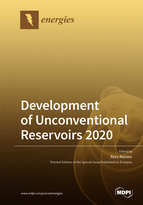Development of Unconventional Reservoirs 2020
A special issue of Energies (ISSN 1996-1073). This special issue belongs to the section "H: Geo-Energy".
Deadline for manuscript submissions: closed (31 October 2020) | Viewed by 91342
Special Issue Editor
Interests: formation evaluation; petrophysics; unconventional gas (tight gas sand and shale gas); reservoir characterization and modeling
Special Issues, Collections and Topics in MDPI journals
Special Issue Information
Dear Colleagues,
This Special Issue is a continuation of the previous successful Special Issue "Development of Unconventional Reservoirs". You can find the information and published papers of the previous Special Issue at https://www.mdpi.com/journal/energies/special_issues/development_unconventional_reservoirs
The need for energy is increasing, and at the same time production from conventional reservoirs is declining quickly. This requires an economically and technically feasible source of energy for the coming years. Among some alternative future energy solutions, the most approachable source is from unconventional reservoirs. As the name “unconventional” implies, it requires a different and challenging approach to characterize and develop such a resource. This Special Issue will attempt to cover the most pressing technical challenges for developing unconventional energy sources from shale gas, shale oil, tight gas sand, coalbed methane, and gas hydrates.
Topics of interest for publication in this Special Issue include, but are not limited to:
- Reservoir characterization of unconventional plays;
- Petrophysical and well–log interpretation challenges of unconventional reservoirs;
- Geomechanical and drilling aspects of unconventional reservoirs;
- Hydraulic fracturing challenges;
- Rock physics analysis of unconventional reservoirs;
- Completion, reservoir management, and surveillance of unconventional reservoirs;
- Unconventional reservoirs’ environmental issues and challenges.
Prof. Reza Rezaee
Guest Editor
Manuscript Submission Information
Manuscripts should be submitted online at www.mdpi.com by registering and logging in to this website. Once you are registered, click here to go to the submission form. Manuscripts can be submitted until the deadline. All submissions that pass pre-check are peer-reviewed. Accepted papers will be published continuously in the journal (as soon as accepted) and will be listed together on the special issue website. Research articles, review articles as well as short communications are invited. For planned papers, a title and short abstract (about 100 words) can be sent to the Editorial Office for announcement on this website.
Submitted manuscripts should not have been published previously, nor be under consideration for publication elsewhere (except conference proceedings papers). All manuscripts are thoroughly refereed through a single-blind peer-review process. A guide for authors and other relevant information for submission of manuscripts is available on the Instructions for Authors page. Energies is an international peer-reviewed open access semimonthly journal published by MDPI.
Please visit the Instructions for Authors page before submitting a manuscript. The Article Processing Charge (APC) for publication in this open access journal is 2600 CHF (Swiss Francs). Submitted papers should be well formatted and use good English. Authors may use MDPI's English editing service prior to publication or during author revisions.
Keywords
- unconventional reservoirs
- shale gas and oil
- tight gas sand
- coal bed methane
- gas hydrates






